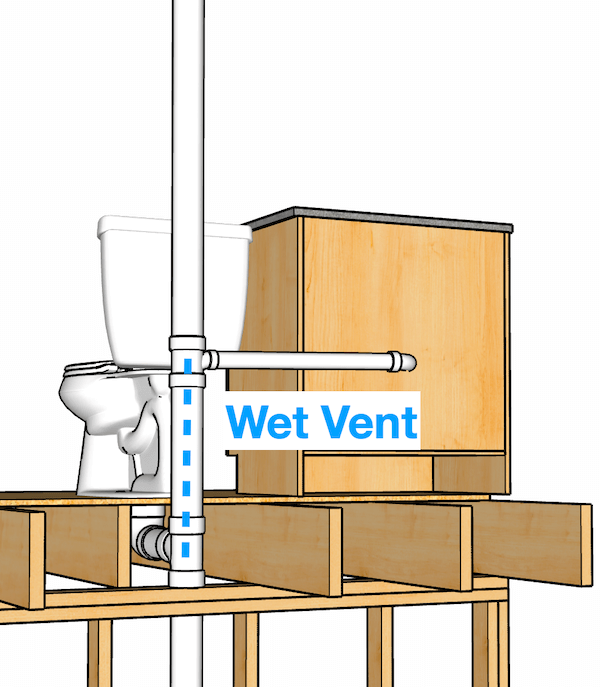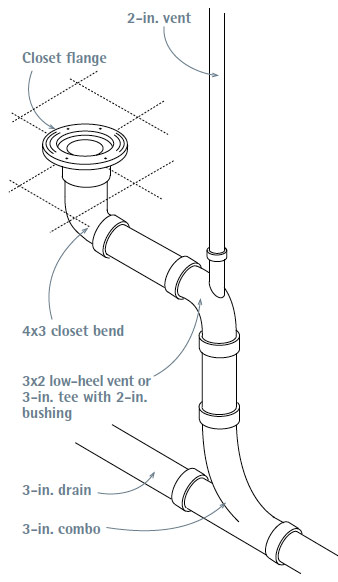How Adequate Ventilation is Crucial for Plumbing Systems
How Adequate Ventilation is Crucial for Plumbing Systems
Blog Article
We have stumbled on the article pertaining to What Is A Plumbing Vent & How Do They Work? directly below on the web and decided it made sense to talk about it with you here.

Appropriate air flow in pipes systems is usually forgotten, yet it is essential for maintaining the functionality and security of your home's pipes. Air flow aids control air pressure, stop the build-up of unsafe gases, and make certain the effective elimination of waste. In this guide, we will certainly check out the relevance of appropriate pipes ventilation, just how it works, and the advantages it offers your plumbing system.
How Ventilation Works in Plumbing Equipments
Air Pressure Guideline
Correct ventilation preserves balanced air pressure within the pipes system. When water moves via pipelines, it displaces air. Without ample air flow, this displacement can produce adverse stress, causing slow down drains or siphoning of water from traps, which can create unpleasant odors to permeate right into the home.
Avoiding Drain Gas Buildup
Among one of the most important features of pipes vents is to stop sewage system gases, such as methane and hydrogen sulfide, from accumulating within the home. These gases can pose severe wellness dangers and are extremely combustible. Vent pipelines permit these gases to leave securely outside.
Assisting in Waste Removal
Ventilation assists in the effective elimination of wastewater by avoiding airlocks in the drainage system. When air can move openly via the vents, it permits water and waste to move efficiently via the pipelines, reducing the threat of obstructions and back-ups.
Benefits of Proper Air Flow
Improved System Performance
Correctly ventilated plumbing systems operate more successfully, with fewer clogs, faster draining pipes, and less stress on the pipes. This efficiency prolongs the life expectancy of the pipes system.
Improved Air Quality
By protecting against sewer gases from entering your home, correct ventilation adds to far better interior air high quality, making your living setting healthier and more comfy.
Avoiding Water Damage
Ample ventilation helps prevent water from being siphoned out of traps, which can result in sewage system gases entering the home and triggering water damage gradually.
Steps to Ensure Correct Air Flow
Consulting Pipes Codes
Constantly speak with neighborhood pipes codes when developing or modifying your plumbing system. These codes supply the necessary standards for correct airing vent and ensure your system satisfies security standards.
Routine Inspection and Maintenance
Regular assessments can assist identify potential air flow problems before they end up being significant issues. Maintenance tasks, such as cleaning vent pipelines and checking for clogs, are necessary for keeping the system in good working order.
Expert Installment
For new installments or major adjustments, it's wise to work with a specialist plumber. They have the knowledge to make certain the ventilation system is correctly developed and installed according to code.
Comprehending Air Flow in Plumbing
Ventilation in plumbing describes the network of pipes that allow air to stream through the drainage system. These vents serve numerous purposes, consisting of managing air pressure within the pipelines, protecting against drain gases from entering the home, and assisting in the smooth circulation of wastewater.
Kinds Of Pipes Vents
Key Stack Vent
The primary stack air vent, likewise referred to as the vent pile, is the primary air vent in a plumbing system. It expands from the main drain align with the roof, enabling gases to run away and fresh air to enter the system.
Branch Vent
Branch vents connect to the major stack vent and serve specific components, such as sinks, commodes, and showers. These vents guarantee that each fixture has adequate air flow to function effectively.
Air Admittance Shutoff (AAV).
An Air Admittance Valve (AAV) is a one-way valve that allows air to get in the plumbing system without the requirement for a traditional vent pipeline prolonging through the roofing system. AAVs are generally utilized in restorations or areas where setting up a common vent is unwise.
Signs of Poor Air Flow in Plumbing.
Slow Draining Fixtures.
If your sinks, bathtubs, or bathrooms are draining pipes slowly, maybe an indicator of inadequate air flow. Inadequate air circulation can create a vacuum cleaner effect, making it difficult for water to drain pipes correctly.
Gurgling Seems.
Gurgling audios originating from drains are frequently a result of air being drawn with water traps due to adverse pressure in the pipelines. This is a clear indication of insufficient ventilation.
Undesirable Smells.
Sewage system smells inside your home are a red flag that your pipes system is not properly ventilated. This might mean that drain gases are not being effectively vented outside, causing possibly hazardous problems.
Common Air Flow Mistakes.
Insufficient Vent Sizing.
Using undersized vent pipes can result in bad air flow and stress discrepancies in the system. It's vital to utilize vents that satisfy the particular needs of your plumbing system.
Improper Vent Placement.
Positioning vents as well far from the fixtures they offer can lower their efficiency. Correct positioning ensures that air can move freely and efficiently through the system.
Ignoring Code Requirements.
Building ordinance offer specific guidelines for plumbing air flow. Overlooking these codes can cause a system that falls short to work appropriately and might result in pricey repairs or carcinogen.
Verdict.
Proper air flow is a critical part of any type of plumbing system, ensuring that it works effectively and safely. By comprehending the importance of ventilation, recognizing the indications of bad air flow, and taking actions to preserve your system, you can avoid pricey concerns and shield your home's air quality.
4 Things You Should Know About Your Plumbing Vents
What Plumbing Vents Are
Also called a vent stack, a plumbing vent is a vertical pipe attached to your drain line that runs through your roof. The plumbing vent pipe, or plumbing air vent, removes gas and odors from your plumbing system and allows fresh air to enter the pipes, helping the water to flow out of the drain pipes.
What Plumbing Vents Do
Plumbing vents have two basic functions. One of which is to allow unpleasant smelling wastewater and sewer gasses to escape your plumbing system instead of entering your home. Plumbing vent pipes are typically located on roofs, away from windows, to ensure the fumes exit the home completely.
The other function of the plumbing vent is to move fresh air into your plumbing system. This helps move water through every plumbing fixture in your house, like toilets and sink drains. Think of the way in which you need to let a little air into the bottle as you pour soda in order to make the drink flow smoothly.
Different Types of Plumbing Vents
True vent: This is the most common vent option. In simplest terms, a true vent is a vertical pipe attached to your drain line that exits through the roof. They often function as the main vent that other fixtures can connect to. Re-vent pipe or auxiliary vent: Attached to the drain line near specific plumbing fixtures, re-vent pipes run up and over to connect to the main vent. Common vent: Two plumbing fixtures installed on opposite sides of a wall are typically tied into the vent stack using something known as a sanitary cross. Wet vent: This venting option operates as a drain pipe and a vent at the same time. Wet vent drainage systems drain water from one fixture while venting the air from another. Although they’ve been used for over 100 years, wet vent systems have only recently been added to the plumbing code in many areas. If you’re planning on installing one in a bathroom remodel, make sure you check your local code prior to construction. Loop vent: For free-standing fixtures like kitchen island sinks, loop vents are ideal. These vent pipes run under the floor, rise from the P-trap, and create a loop inside the cabinet sink. Air admittance valve: An AAV is a one-way mechanical valve typically installed at the site of the plumbing fixture. AAVs allow venting to occur without having to tie into a larger venting system. They’re ideal for venting fixtures where you aren’t able to easily connect to an existing vent system. Common Plumbing Vent Issues
Although vent pipes typically don’t have water flowing through them, they’re still subject to many typical plumbing issues. For example, clogs are one of the most common problems associated with sewer vent pipes. If your vent pipe gets clogged, all of your plumbing fixtures tied into the vent stack will be affected.
A sink with a slow drain that bubbles and gurgles or a strong sewage smell around your toilet are both indicators that your toilet vent pipe is clogged. Because most vent pipes exit through the roof, old leaves, twigs or even a bird’s nest could be clogging the pipe.
Clogs in your vent pipe system cause a buildup of negative pressure, meaning that water won’t be able to flow out of your home very well. It’s similar to putting your finger over the opening of a straw to trap water inside. When you remove your finger, the water is able to flow out of the straw.
If you suspect you have any blockage in your vent, make sure you have a professional come examine the situation. Left unchecked, a blocked air vent can lead to other costly repairs, like leaks and sediment buildup.
Under Pressure
Pipe vents are essential aspects of a home’s plumbing system. Owning a home means learning about all sorts of things you never put much thought into before. But by understanding as much as you can about the important systems of your home, you can keep those budgets intact and those anxiety levels low.
https://www.homeserve.com/en-us/blog/home-improvement/plumbing-vents/

Do you really like reading about Why Plumbing Air Vents Are Important? Try leaving a comment further down. We will be pleased to listen to your suggestions about this blog posting. We are looking forward that you visit us again in the near future. Make sure you set aside a second to share this blog post if you appreciated it. I take joy in reading our article about Essential Plumbing Vent Pipes: Understanding Their Role.
Schedule Your Service Report this page